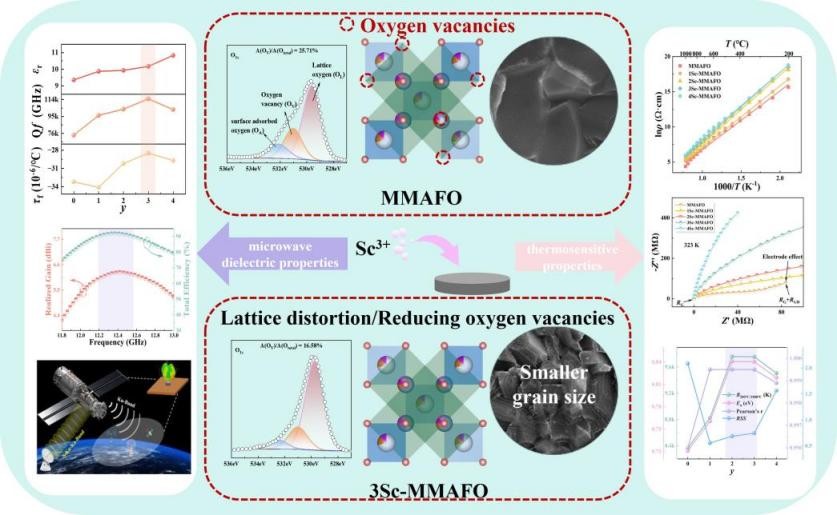Progress Achieved in Research on Multifunctional Microwave-Thermosensitive Ceramic Materials for 6G RF Front-End
Editor: | Sep 03,2025
With 5G/6G communication technologies evolving toward Space-Air-Ground-Sea-Integrated Networks (SAGSIN), the bottleneck for traditional functional ceramics lies in simultaneously achieving stable microwave signal transmission alongside precise temperature sensing over a wide temperature range. For millimeter-wave expansion into Ku/Ka bands, microwave dielectrics require: 1) tunable εr; 2) high Q·f; 3) near-zero τf. Meanwhile, NTC thermistors (as system “thermal managers”) need high linearity and B-value over wide temperatures for real-time drift calibration. Conventional spinel ceramics typically exhibit prominent performance in only one functionality. For example, the Mg-Al-Mn-Fe-O ceramic—synthesized via solid solution of high-resistivity MgAl2O4 and semiconducting MnFe2O4—achieves a B-value of 8056 K, yet remains constrained by oxygen vacancy-induced charge imbalance and consequent non-Arrhenius behavior, thereby hindering concurrent optimization of microwave properties and thermistor linearity.
Recently, researchers from the Laboratory of Materials Physics and Chemistry at the Xinjiang Technical Institute of Physics and Chemistry, CAS, addressed the critical challenge of high-temperature nonlinear electrical properties coupled with microwave loss in Mg-Al-Mn-Fe-O spinel ceramics. This approach concurrently suppresses oxygen vacancy diffusion (as confirmed by XPS/EPR quantification showing reduction from 25.71% to 16.58%) and reinforces octahedral bond valences, thereby enhancing structural stability. Experimental results demonstrate Sc3+-modified ceramics achieve exceptional linear NTC characteristics (B200℃/1000℃ = 8367-9758 K, Pearson’s r up to 0.9995) across 200-1000 °C, fulfilling stringent requirements for high-precision wide-temperature sensing. Concurrently, an optimal balance among key microwave dielectric properties is realized: low εr (10.08), ultra-high Q·f (149,000 GHz), and near-zero τf (-10.2×10-6/°C), attributed to Sc3+-induced lattice stabilization and grain refinement (average grain size reduced to ~2.47 μm). A cylindrical dielectric resonator antenna (CDRA) prototype fabricated with optimized Mg0.8Mn0.2Al1.3Sc0.3Fe0.4O4 ceramic exhibits excellent performance in the Ku-band, achieving a radiation efficiency of 92% and a gain of 6.28 dBi at 12 GHz. This robustly validates its potential for self-temperature-compensated RF modules in next-generation satellite communication front-ends and 6G massive MIMO systems, representing a breakthrough in multifunctional ceramic integration strategies.
The study entitled “Sc3+-modified Mg-Al-Mn-Fe-O spinel ceramics with co-enhanced microwave dielectric and thermosensitive properties for multifunctional applications” has been published in Journal of Advanced Ceramics. The Xinjiang Technical Institute of Physics and Chemistry, Chinese Academy of Sciences served as the primary contributing institution. Doctoral candidate Wenyuan Li is the first author, with his supervisor, Professor BoZhang, acting as corresponding author. This work was supported by the Natural Science Foundation of Xinjiang Uygur Autonomous Region, Xinjiang Tianshan Talent Training Program, National Natural Science Foundation of China, and the Youth Innovation Promotion Association of CAS.

Figure. Structure, performance and application prospects of the prepared ceramics. (Image by Prof. ZHANG Bo's group)
附件下载:
 (86) 991-3838931
(86) 991-3838931 lhskj@ms.xjb.ac.cn
lhskj@ms.xjb.ac.cn (86)991-3838957
(86)991-3838957 40-1 Beijing Road
Urumqi, XinjiangChina
40-1 Beijing Road
Urumqi, XinjiangChina